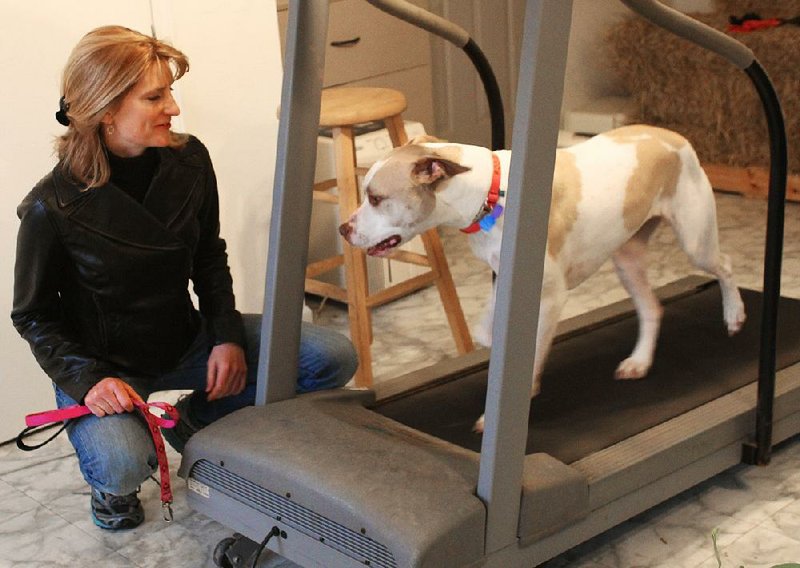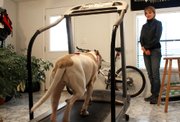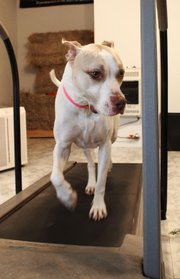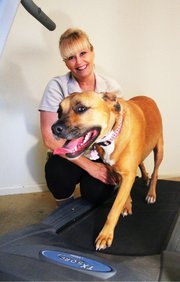LITTLE ROCK — Heather Larkin and her dog Rosie regularly include brisk walks around their Little Rock neighborhood as part of a fitness regimen.
When weather and other situations interfere with their outings, Larkin heads to the gym.
Rosie, a well-behaved boxer mix, has a backup plan too - she trots on a treadmill.
Good idea, says trainer Jamie Walden of See Spot Sit Dog Training in Sherwood.
“Hands down, the majority of behavior problems we see are because of a lack of sufficient exercise. And a ‘big backyard’ mind-set causes many to think their dogs are properly exercised when they aren’t.”
For Larkin, president and chief executive officer of Arkansas Community Foundation,the treadmill “is not a substitute for walking; we walk twice a day most of the time. But if I’m getting ready to travel for work or I’ve got company coming over, I put her on the treadmill to get her some exercise and take the edge off.
“In the winter, I use it more.”
Charlotte Mallion, also a trainer at See Spot Sit, agrees.
“A treadmill doesn’t take the place of walking. Dogs like to be out. But it’s a great way to get some indoor exercise or shorten an outdoor walk.”
Rosie is a rescue dog who was about 2 years old when Larkin adopted her in 2006.
“She was sweet and crazy - so energetic,” Larkin remembers.
“I was desperate to keep her from tearing down the house.
The first thing I did was take her to agility lessons with Lisa Mantle at Running Dog Academy [in Roland]. She saved us.”
The treadmill was an unexpected addition to Rosie’s fitness routine. “I was working out at my gym where they had a treadmill that was wearing out but still ran,” Larkin says.
“They were going to put it out on the curb. I wondered if Rosie could learn to use it, so I asked if I could have it. They said sure, so I brought it home.”
Treats tempted Rosie onto the treadmill. “She’s very brave, not scared of much,” Larkin says. “After I got her on it with her leash, I started walking on it. She looked surprised but figured it out and started walking too.
“It was so easy. She took right to it.”
For several weeks, Larkin says, “I had her on a leash on the treadmill - not at an all out speed, but at a walk or trot. Now all I have to say is, ‘Rosie, get on your treadmill,’ and she gets on it and starts going. I set it at 5 mph with a slight incline.”
Rosie is often excited at first “and sort of over-reaches on it, then settles down,” Larkin says. “I sit there next to her on a chair and read while she’s on it, which is usually about 15 or 20 minutes.”
Larkin made all the right moves - introducing a dog to a treadmill should be done with care, Mallion says. Physically forcing a dog onto a moving treadmill is a good way to make sure the dog becomes terrified of it.
“First and foremost, you want to gauge your dog’s anxiety or fear, if any, to the treadmill motion and noise,” she says. “You can do this just by turning it on with the dog within 6 feet of the machine to see if he reacts to it at all.
“If a dog shows extreme fear or bolts as soon as you turn it on, you absolutely must back up and go slowly or you can cause more damage, making it much more difficult to get them to stay on long enough to realize it is fun.”
For dogs that are moderately or extremely afraid, “you may have to spend up to a week, working short sessions each day, just to get the dog near the machine while it is still,” she says. “Patience is the key. Never physically force the dog. Keep getting closer until he is right at the edge.”
DAY ONE
With her 4-year-old dog Marilyn - like Rosie, a rescue dog- “I started out just tossing treats onto the treadmill close to the edge so she could get the treat without having to put even one paw on the machine,” Mallion says. “I did probably 15 repetitions of this and every time she took the treat, I praised her.
“This is strictly to get the dog accustomed to the surface of the treadmill. I did it with her four or five times throughout the course of Day One.”
Then, she says, “I stepped it up a little by putting the treats in positions that forced her to put her front paws on the treadmill, with lots of praise every time. Again, about 15 repetitions.
“The process goes faster if you can do it at least three times a day, even if it’s just five minutes each time.”
Not working? Raise the value of the treat. Start with kibble or regular dog treats like Milk Bones or Snausages.
“If these won’t entice them to get all the way up on the machine, pull out the big guns of treats and give them some tiny pieces of cheese, turkey, hot dog or boiled chicken,” Mallion says. “If your dog has an absolute favorite treat, use that.”
DAY TWO
Once touching the treadmill is mastered, she says, “you can stand in front of the dog and talk to her while she has her front paws on the treadmill. Small dogs are easier to lure onto the machine from the front, on leash. Larger dogs, I have found, learn more easily from the side position.”
Next step, all four paws. “I used the command ‘all the way up’ to let Marilyn know that I wanted all fours on there before she got the treat,” Mallion says.
“You reinforce this command by saying that phrase when the dog is all the way on the treadmill - ‘All the way up! Good dog!’ - in a very happy voice. It helps if your dog knows the ‘up’ command already, which makes it easier to understand ‘all the way up.’”
After getting the dog on the treadmill, “I would have her sit and wait,” Mallion says. “I like this because it gives the dog a chance to get used to being on the treadmill for a longer period of time than just retrieving a treat. We did this three or four times on Day Two.”
DAY THREE
On the third day, “I gave her the ‘up’ command, held the leash and stood on the outside of the treadmill; the other side was against the wall to make Marilyn feel safe. I turned it on and adjusted it to 1 mile per hour.
“The whole time I was praising her and giving her tiny pieces of cut-up boiled chicken, a high-value treat, and talking calmly. I also started using the ‘walk’ command because she knows it means ‘Let’s walk.’”
Because Marilyn took to it quickly, Mallion says, “I was able to get her up to 3 mph on the third day. Anything less doesn’t really exercise them, so that should be the goal.
“It is also a great idea to start adding some incline for about three minutes, then reduce it back to flat for a few minutes, then incline again - much the way you would do it for yourself.”
Watch your dog closely to see if he is struggling at all, she recommends. “If he is lagging or panting too hard, slow it down, cool down and end the exercise. It’s best to do shorter intervals until he builds up some stamina.”
Even if the dog appears comfortable, “It is very important that people always remember never to leave the dog unattended on a treadmill,” Mallion says.
REQUIRED EQUIPMENT
To get started, all you need is a treadmill, a leash and a flat collar (not a choke chain).
“There are animal-powered [manual] treadmills that don’t have an electrical power source,” Mallion says. “These are great for dogs who love the treadmill and are strong enough to get it going [prices start around $100]. Mine is just a human electric-powered treadmill, but there are also electric-powered doggy treadmills. I have found they are quite expensive.”
A brand called Dogpacer offers a Minipacer treadmill for small dogs for $479 and a larger model for $499 at dogpacer.com.
She says used motorized treadmills are easy to find wherever used sporting goods are listed.
Using a treadmill, Larkin says, is the perfect solution for getting a lively dog to burn off some of that boundless enthusiasm. “I’ve ridden bikes with Rosie on a leash, which worked OK until something like a squirrel ran in front of us, then Rosie took off and the bike would go down,” Larkin says. “This works much better.” A detailed, step-by-step video instruction posted by Neuman K-9 Academy can be found at Youtube.com by searching for “Treadmill Training Your Canine.” More information about See Spot Sit training, which is conducted in a fenced park behind Sherwood Animal Shelter, 6500 North Hills Blvd., Sherwood, is at seespotsit.org; Mallion’s phone number is (501) 612-1171.
ActiveStyle, Pages 23 on 01/14/2013



